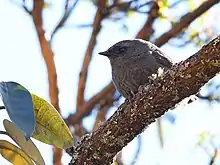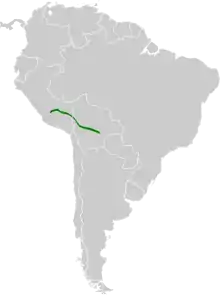Puna tapaculo
The puna tapaculo (Scytalopus simonsi) is a species of bird in the family Rhinocryptidae. It is found in Bolivia and Peru.[2]
| Puna tapaculo | |
|---|---|
 | |
| Scientific classification | |
| Domain: | Eukaryota |
| Kingdom: | Animalia |
| Phylum: | Chordata |
| Clade: | Dinosauria |
| Class: | Aves |
| Order: | Passeriformes |
| Family: | Rhinocryptidae |
| Genus: | Scytalopus |
| Species: | S. simonsi |
| Binomial name | |
| Scytalopus simonsi Chubb, 1917 | |
 | |
Taxonomy and systematics
What is now known as the puna tapaculo was originally described as a species in 1917.[3] It was later treated as synonymous with Tschudi's tapaculo (Scytalopus acutirostris).[4] Still later it was treated as Scytalopus magellanicus simonsi, a subspecies of Magellanic tapaculo.[5] Following a study published in 1997, it was elevated to species rank because of differences in their vocalizations.[6][7] Its English name honors American scientific collector Perry O. Simons.[8]
Description
The puna tapaculo is 10 to 12 cm (3.9 to 4.7 in) long. Three males weighed 15.7 to 20 g (0.55 to 0.71 oz) and a female 15.7 g (0.55 oz). The adult male's upper parts are gray, often washed with brown on the neck and back. It has a narrow pale supercilium. The throat and breast are also gray. The rump, flanks, and belly can be cinnamon or olive-buff and have dark bars. The adult female is similar to the males that have the brown wash; otherwise they may be paler. Immatures are paler overall but have a heavier brown wash on the upper parts. The entire underside is barred.[9]
Distribution and habitat
The puna tapaculo is found on the eastern slope of the Andes at elevations of 2,900 to 4,300 m (9,500 to 14,100 ft) from Cordillera Vilcanota in Peru's Department of Cuzco southeast to Bolivia's Cochabamba Department. It inhabits elfin forest at tree line and above there is in small shrubs and trees among grass tussocks. It can also be found in Polylepis woodlands.[9]
Behavior
Feeding
Though very little is known about the puna tapaculo's diet, the species is probably insectivorous though seeds are also eaten.[9]
Breeding
Very little is also known about the puna tapaculo's breeding phenology. One nest has been described; it was a cup lined with grass, placed at the end of a burrow approximately 1 m (3.3 ft) deep. It had a dome of loosely woven grass over it and contained two eggs. After hatching, both adults provisioned the nestlings.[9]
Vocalization
The song of the puna tapaculo was described by D.L. Lane as "a series of descending churred phrases: tcherr tcherr tcherr tcherr ...." . Lane described a call as "a descending whinny: djee-ee-ee-eer" .[10]
Status
The IUCN has assessed the puna tapaculo as being of Least Concern.[1] Though it has a restricted range and its population has not been quantified, "In the short term, the puna tapaculo is little affected by human activity".[9]
References
- BirdLife International (2016). "Puna Tapaculo Scytalopus simonsi". IUCN Red List of Threatened Species. 2016. Retrieved 1 May 2021.
- Gill, F.; Donsker, D.; Rasmussen, P. (January 2021). "IOC World Bird List (v 11.1)". Retrieved January 14, 2021.
- Chubb, C (2017). "Scytalopus simonsi, sp. nov." Bulletin of the British Ornithologists' Club. 38: 17. Retrieved May 2, 2021.
- Zimmer, J.T. (1939). Studies of Peruvian birds 32. The genus Scytalopus. Amer. Mus. Novit.. 1044: 1-18
- Peters, J. L. 1951. Check-list of birds of the world. Volume VII. Museum of Comparative Zoology, Cambridge, Massachusetts.1 https://www.biodiversitylibrary.org/page/14480624#page/301/mode/1up retrieve May 1, 2021
- Krabbe, N., and T.S. Schulenberg. 1997. Species limits and natural history of Scytalopus tapaculos (Rhinocryptidae), with descriptions of the Ecuadorian taxa, including three new species. Pages 47-88 in J. V. Remsen, Jr. (editor), Studies in neotropical ornithology honoring Ted Parker. Ornithological Monographs number 48. American Ornithologists' Union, Washington, D.C.
- Remsen, J. V., Jr., J. I. Areta, E. Bonaccorso, S. Claramunt, A. Jaramillo, D. F. Lane, J. F. Pacheco, M. B. Robbins, F. G. Stiles, and K. J. Zimmer. Version 19 January 2021. A classification of the bird species of South America. American Ornithological Society. https://www.museum.lsu.edu/~Remsen/SACCBaseline.htm retrieved January 19, 2021
- Beolens, Bo; Watkins, Michael; Grayson, Michael (2014). The Eponym Dictionary of Birds. Bloomsbury Publishing. p. 1172. ISBN 9781472905741.
- Schulenberg, T. S. (2020). Puna Tapaculo (Scytalopus simonsi), version 1.0. In Birds of the World (T. S. Schulenberg, Editor). Cornell Lab of Ornithology, Ithaca, NY, USA. https://doi.org/10.2173/bow.puntap1.01 retrieved May 2, 2021
- Schulenberg, T. S., D. F. Stotz, D. F. Lane, J. P. O’Neill, and T. A. Parker III (2007) Birds of Peru. Princeton University Press, Princeton, New Jersey.
